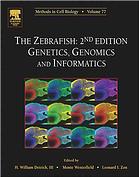

Most ebook files are in PDF format, so you can easily read them using various software such as Foxit Reader or directly on the Google Chrome browser.
Some ebook files are released by publishers in other formats such as .awz, .mobi, .epub, .fb2, etc. You may need to install specific software to read these formats on mobile/PC, such as Calibre.
Please read the tutorial at this link. https://ebooknice.com/page/post?id=faq
We offer FREE conversion to the popular formats you request; however, this may take some time. Therefore, right after payment, please email us, and we will try to provide the service as quickly as possible.
For some exceptional file formats or broken links (if any), please refrain from opening any disputes. Instead, email us first, and we will try to assist within a maximum of 6 hours.
EbookNice Team

Status:
Available0.0
0 reviews
ISBN 10: 0125641729
ISBN 13: 9780125641722
Author: H William Detrich III Monte Westerfield, Leonard I Zon
This volume of Methods in Cell Biology, the second of two parts on the subject of zebrafish, provides a comprehensive compendia of laboratory protocols and reviews covering all the new methods developed since 1999. This second volume covers advances in forward and reverse genetic techniques, provides an update on the zebrafish genome and gene/mutant mapping technologies, examines the new systems for efficient transgenesis in the zebrafish, provides an in-depth view of informatics and the emerging field of comparative genomics, and considers the extensive infrastructure now available to the zebrafish community.
PART I: Forward and Reverse Genetics
Chapter 1. Retroviral-Mediated Insertional Mutagenesis in Zebrafish
I. Introduction
II. Mutagenesis
III. Cloning the Mutated Genes
IV. Future Directions
References
Chapter 2. Genetic Screens for Maternal-Effect Mutations
I. Introduction
II. Strategies for Maternal-Effect Screens
III. Selection of Lines for Genetic Screens
IV. Recovery and Maintenance of Maternal-Effect Mutations
V. Mapping Maternal-Effect Mutations
VI. Solutions, Materials, and Protocols
VII. Conclusions
References
Chapter 3. Behavioral Screening Assays in Zebrafish
I. Introduction
II. General Considerations
III. Behavioral Assays
IV. Conclusions
References
Chapter 4. Target-Selected Gene Inactivation in Zebrafish
I. Introduction
II. Gene Targeting Strategies
III. Target-Selected Mutagenesis in Zebrafish
IV. Discussion
V. Materials and Methods
References
Chapter 5. A High-Throughput Method for Identifying N-Ethyl-N-Nitrosourea (ENU)-Induced Point Mutati
I. Introduction
II. Rationale for Reverse Genetics in Zebrafish
III. Rationale for Using the CEL1 Assay to Detect Induced Mutations
IV. Rationale for Generating a Cryopreserved Mutant Library
V. Method of N-Ethyl-N-Nitrosourea (ENU) Mutagenesis and Rearing of F1 Founder Fish
VI. Generating a Cryopreserved Mutant Library
VII. Isolating Genomic DNA
VIII. Choosing Fragments to Screen
IX. CEL1 Endonuclease Assay
X. Recovery of Mutations from Cryopreserved Sperm
XI. Materials Cost Estimate
References
Chapter 6. Production of Zebrafish Germline Chimeras by Using Cultured Embryonic Stem (ES) Cells
I. Introduction
II. Methods
III. Reagents
IV. Future Directions
References
Chapter 7. Nonconventional Antisense in Zebrafish for Functional Genomics Applications
I. Introduction
II. General Use of Nonconventional Antisense Tools in Zebrafish
III. Use of Morpholinos (MOs) as Antisense Tools in Zebrafish
IV. Comparison of MO-Based Screening Success to Mutational Methods
References
Chapter 8. Downregulation of Gene Expression with Negatively Charged Peptide Nucleic Acids (PNAs) in
I. Introduction
II. Materials and Methods
III. Results
IV. Discussion
V. Summary
References
Chapter 9. Photo-Mediated Gene Activation by Using Caged mRNA in Zebrafish Embryos
I. Introduction
II. Synthesis of Bhc-Caged mRNA
III. Microinjection of the Bhc-Caged mRNA
IV. Uncaging by Illumination of UV Light
V. Titration of Caging Efficiency
VI. Injection of Dimethyl Sulfoxide (DMSO) Solution of Caged mRNA
References
Chapter 10. Current Status of Medaka Genetics and Genomics The Medaka Genome Initiative (MGI)
I. Introduction
II. Current Status of Medaka Genetics
III. Current Status of Medaka Genomics
IV. Other Progress
V. Internet Web Sites Relevant to Medaka Resources and Databases
References
Chapter 11. Transgenesis and Gene Trap Methods in Zebrafish by Using the Tol2 Transposable Element
I. Introduction
II. Transgenesis by Using the Tol2 Transposable Element in Zebrafish
III. A Gene Trap Approach that Uses the Tol2 Transposon System in Zebrafish
IV. Summary and Perspectives
References
PART II: The Zebrafish Genome and Mapping Technologies
Chapter 12. The Zebrafish Genome Project: Sequence Analysis and Annotation
I. Introduction
II. Automated Annotation of Whole Genome Shotgun (WGS) Assemblies
III. Clone-by-Clone Analysis and Annotation
IV. The Sanger Zebrafish Web Services
V. Future Releases
References
Chapter 13. Molecular Cytogenetic Methodologies and a Bacterial Artificial Chromosome (BAC) Probe Pa
I. Introduction
II. Methods
III. First-Generation Zebrafish BAC Probe Panel
References
Chapter 14. Automated Analysis of Conserved Syntenies for the Zebrafish Genome
I. Introduction
II. The Conservation of Zebrafish and Mammalian Genomes
III. Using Genome Conservation in Zebrafish Research
IV. Genomic Connections Between Zebrafish and Tetrapods Facilitate Disease Research
V. Bioinformatic Approaches to Automating Zebrafish Connections and Comparative Maps
VI. A Conserved Syntenic Map for Zebrafish: Preliminary Results
VII. Conclusion
References
Chapter 15. Update of the Expressed Sequence Tag (EST) and Radiation Hybrid Panel Projects Yi Zhou
I. Expressed Sequence Tag (EST) Projects
II. Radiation Hybrid (RH) Panel Project
III. Future Directions
References
Chapter 16. Bacterial Artificial Chromosome (BAC) Clones and the Current Clone Map of the Zebrafish
I. Introduction
II. Physical Map of Fingerprinted Clones
III. Screening Methods and Utilization of the Current Zebrafish Clone Map
IV. Example: Discovery of the Zebrafish dicer1 Gene
References
Chapter 17. The Zon Laboratory Guide to Positional Cloning in Zebrafish
I. Introduction
II. Mapping Strains
III. Families and Genetic Markers
IV. Crosses for Line Maintenance and Mapping
V. Preparation of the DNA
VI. Mapping Genes
VII. Overgo Strategy for Rapidly Doing Chromosomal Walks and Positional Cloning
VIII. Protocol for Overgo Probing of High-Density Filters
IX. General Flow of Information from the Radiation Hybrid Panel Maps, the Sanger Institute Sequencin
X. Synteny Between Human, Zebrafish, and Fugu Genomes
XI. Proving a Candidate Gene Is Responsible for the Mutant Phenotype
XII. Morpholinos
References
the zebrafish book
the zebrafish book pdf
the zebrafish genome sequencing project bioinformatics resources
the zebrafish
the zebrafish in biomedical research
Tags: H William Detrich III Monte Westerfield, Leonard I Zon, Zebrafish, Genetics